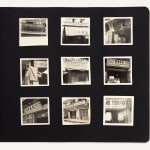[Signage]
Typological Album Documenting Multi-Language Signage in Phuket Town, Thailand, 1920s
Silver prints (168)
Most 1 5/8 x 1 5/8 inches; three larger
Mostly mounted 9 per page.
Mostly mounted 9 per page.
Further images
-
(View a larger image of thumbnail 1
)

-
(View a larger image of thumbnail 2
)

-
(View a larger image of thumbnail 3
)

-
(View a larger image of thumbnail 4
)

-
(View a larger image of thumbnail 5
)

-
(View a larger image of thumbnail 6
)

-
(View a larger image of thumbnail 7
)

-
(View a larger image of thumbnail 8
)

-
(View a larger image of thumbnail 9
)

-
(View a larger image of thumbnail 10
)

-
(View a larger image of thumbnail 11
)

-
(View a larger image of thumbnail 12
)

A dense and dynamic typological survey, this album documents scores of shop signs which lined the bustling streets of Phuket Town, Thailand, in the late 1920s or early 1930s. In...
A dense and dynamic typological survey, this album documents scores of shop signs which lined the bustling streets of Phuket Town, Thailand, in the late 1920s or early 1930s.
In the early 1900s, Phuket was one of the world’s major exporters of tin, which was mined throughout the island primarily by Chinese laborers. Large-scale tin mining efforts began in the 19th-century, in part because the invention of the tin can sparked a global demand for it. In the early-20th century, under Governor Phraya Ratsadanupradit Mahitsaraphakdi, major European mining companies were brought in, and major public infrastructure such as roads and canals was built. Phuket City, the island’s capital, therefore became a hub for the miners, laborers, engineers, prospectors, from China, Europe, India, and elsewhere throughout the world.
All of the area’s rich, multicultural history is reflected through different aspects of the album. Almost all of the signs in the album are written in Thai, Chinese, and English and the majority of the businesses are Chinese-owned. The predominance of the tin mining industry can be seen in the many advertisements for engineers, carpenters, manufacturers, electricians and general contractors. Advertisements for auto repair and private drivers reflect the modernization of public infrastructure.
Also present are signs for doctors, dentists, pharmacists, sign painters, art galleries, photo studios, curio shops, liquor stores, and other aspects of a multicultural, metropolitan hub.
In the early 1900s, Phuket was one of the world’s major exporters of tin, which was mined throughout the island primarily by Chinese laborers. Large-scale tin mining efforts began in the 19th-century, in part because the invention of the tin can sparked a global demand for it. In the early-20th century, under Governor Phraya Ratsadanupradit Mahitsaraphakdi, major European mining companies were brought in, and major public infrastructure such as roads and canals was built. Phuket City, the island’s capital, therefore became a hub for the miners, laborers, engineers, prospectors, from China, Europe, India, and elsewhere throughout the world.
All of the area’s rich, multicultural history is reflected through different aspects of the album. Almost all of the signs in the album are written in Thai, Chinese, and English and the majority of the businesses are Chinese-owned. The predominance of the tin mining industry can be seen in the many advertisements for engineers, carpenters, manufacturers, electricians and general contractors. Advertisements for auto repair and private drivers reflect the modernization of public infrastructure.
Also present are signs for doctors, dentists, pharmacists, sign painters, art galleries, photo studios, curio shops, liquor stores, and other aspects of a multicultural, metropolitan hub.
![[Signage], Typological Album Documenting Multi-Language Signage in Phuket Town, Thailand, 1920s](https://artlogic-res.cloudinary.com/w_1600,h_1600,c_limit,f_auto,fl_lossy,q_auto/artlogicstorage/dollc/images/view/699b435a39462e5639a592e0b8b401dcj/daniel-oliver-signage-typological-album-documenting-multi-language-signage-in-phuket-town-thailand-1920s.jpg)
![[Signage], Typological Album Documenting Multi-Language Signage in Phuket Town, Thailand, 1920s](https://artlogic-res.cloudinary.com/w_1600,h_1600,c_limit,f_auto,fl_lossy,q_auto/artlogicstorage/dollc/images/view/0b1b72b14389bfd115c864b6e51d6137j/daniel-oliver-signage-typological-album-documenting-multi-language-signage-in-phuket-town-thailand-1920s.jpg)
![[Signage], Typological Album Documenting Multi-Language Signage in Phuket Town, Thailand, 1920s](https://artlogic-res.cloudinary.com/w_1600,h_1600,c_limit,f_auto,fl_lossy,q_auto/artlogicstorage/dollc/images/view/6df66627223b53149a1bcd9f3ad9ea9aj/daniel-oliver-signage-typological-album-documenting-multi-language-signage-in-phuket-town-thailand-1920s.jpg)
![[Signage], Typological Album Documenting Multi-Language Signage in Phuket Town, Thailand, 1920s](https://artlogic-res.cloudinary.com/w_1600,h_1600,c_limit,f_auto,fl_lossy,q_auto/artlogicstorage/dollc/images/view/f3127a2313a472771fb3ee241884d828j/daniel-oliver-signage-typological-album-documenting-multi-language-signage-in-phuket-town-thailand-1920s.jpg)
![[Signage], Typological Album Documenting Multi-Language Signage in Phuket Town, Thailand, 1920s](https://artlogic-res.cloudinary.com/w_1600,h_1600,c_limit,f_auto,fl_lossy,q_auto/artlogicstorage/dollc/images/view/ac4ed0fbd3d93b0e2993070f7033c3a1j/daniel-oliver-signage-typological-album-documenting-multi-language-signage-in-phuket-town-thailand-1920s.jpg)
![[Signage], Typological Album Documenting Multi-Language Signage in Phuket Town, Thailand, 1920s](https://artlogic-res.cloudinary.com/w_1600,h_1600,c_limit,f_auto,fl_lossy,q_auto/artlogicstorage/dollc/images/view/eea3653e1eaef87bbef049244ec14484j/daniel-oliver-signage-typological-album-documenting-multi-language-signage-in-phuket-town-thailand-1920s.jpg)
![[Signage], Typological Album Documenting Multi-Language Signage in Phuket Town, Thailand, 1920s](https://artlogic-res.cloudinary.com/w_1600,h_1600,c_limit,f_auto,fl_lossy,q_auto/artlogicstorage/dollc/images/view/e597053a99758b47c788dcd84929beb8j/daniel-oliver-signage-typological-album-documenting-multi-language-signage-in-phuket-town-thailand-1920s.jpg)
![[Signage], Typological Album Documenting Multi-Language Signage in Phuket Town, Thailand, 1920s](https://artlogic-res.cloudinary.com/w_1600,h_1600,c_limit,f_auto,fl_lossy,q_auto/artlogicstorage/dollc/images/view/9f80b23178ce0cac794cb092e0e0d11aj/daniel-oliver-signage-typological-album-documenting-multi-language-signage-in-phuket-town-thailand-1920s.jpg)
![[Signage], Typological Album Documenting Multi-Language Signage in Phuket Town, Thailand, 1920s](https://artlogic-res.cloudinary.com/w_1600,h_1600,c_limit,f_auto,fl_lossy,q_auto/artlogicstorage/dollc/images/view/c559a35dd1d9d3542abcd960c1668785j/daniel-oliver-signage-typological-album-documenting-multi-language-signage-in-phuket-town-thailand-1920s.jpg)
![[Signage], Typological Album Documenting Multi-Language Signage in Phuket Town, Thailand, 1920s](https://artlogic-res.cloudinary.com/w_1600,h_1600,c_limit,f_auto,fl_lossy,q_auto/artlogicstorage/dollc/images/view/71ccd7d23ba0d37b2fb6a34a18573fcdj/daniel-oliver-signage-typological-album-documenting-multi-language-signage-in-phuket-town-thailand-1920s.jpg)
![[Signage], Typological Album Documenting Multi-Language Signage in Phuket Town, Thailand, 1920s](https://artlogic-res.cloudinary.com/w_1600,h_1600,c_limit,f_auto,fl_lossy,q_auto/artlogicstorage/dollc/images/view/3c8bbffe2c2d6732bad896fc7ea69797j/daniel-oliver-signage-typological-album-documenting-multi-language-signage-in-phuket-town-thailand-1920s.jpg)
![[Signage], Typological Album Documenting Multi-Language Signage in Phuket Town, Thailand, 1920s](https://artlogic-res.cloudinary.com/w_1600,h_1600,c_limit,f_auto,fl_lossy,q_auto/artlogicstorage/dollc/images/view/84299a8c0ff763bf1ad9677f9b464cb3j/daniel-oliver-signage-typological-album-documenting-multi-language-signage-in-phuket-town-thailand-1920s.jpg)